The Geological Society and IERT University of Jammu brought together scientists from the Himalayan nations and around the world, to discuss with policy-makers and community representatives how to develop sustainably the rich and varied resources of the Himalaya, to benefit the local communities and nations to which they belong.
Quick Links: Schools Programme |
Conference Outputs |
Speaker Presentations |
Sponsors |
Photos |
Media Coverage |
Background Information
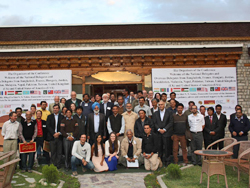 The rich and varied resources of the Himalaya hold the promise of enormous opportunities for local communities and the nations to which they belong.
The rich and varied resources of the Himalaya hold the promise of enormous opportunities for local communities and the nations to which they belong.
Yet unless these resources are developed sustainably, they also have the potential to do great damage to people and environments. Geoscience holds the key to understanding these resources, and their effective and responsible development.
To explore relevant geoscience research and identify lessons for sustainable resource development in the Himalaya and more widely, the Geological Society and the Institute of Energy Research and Training, University of Jammu in collaboration with other local and international partner organisations, held a three-day conference in Leh, Ladakh, in the Indian state of Jammu and Kashmir – an area which is developing rapidly, and which the state and national governments wish to establish as an example of best practice in sustainable development.
Topics addressed at the conference included:
- Advances in understanding the geology of the Himalaya
- Interdisciplinary approaches to social development
- Living in a changing environment
- Meeting energy and water needs sustainably
- Engineering challenges for development in mountain areas
- Natural risks and hazards – earthquakes and landslides
- Tourism opportunities and challenges
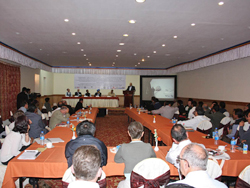
Delegates from the UK and other European nations, the USA, Taiwan, Malaysia and Jordan joined those from Jammu and Kashmir State, elsewhere in India, and other Himalayan nations.
Social scientists and development practitioners attended alongside natural scientists and engineers. This unique gathering provided opportunities for wide-ranging sharing of knowledge and perspectives, and led to fruitful discussions which will be reflected in the conference outputs.
Much of the dialogue focused on the challenges of balancing
factors which may be in conflict – the material needs of local
people and those further away (for example, the billion people
who rely on Himalayan glaciers for their water); local, regional
and national economic growth; and impacts on the
environment, human health and wellbeing. These challenges
are exacerbated by rapid population growth, locally and
globally, and the local effects of global climate change.
Interdisciplinary approaches emerged as key to addressing
these challenges, complementing the geoscience which
underpins and controls so much of the natural system.
Effective community participation and engagement in decisionmaking,
though difficult to achieve, is essential alongside the
application of scientific knowledge and technical expertise.
Delegates also recognised the value of indigenous knowledge,
and of learning from local and traditional ways of life. Cutting edge
science and older forms of knowledge are both vital in
educating the next generation.
back to top
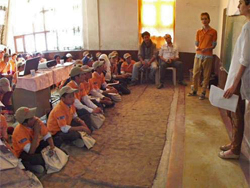 Schools programme
Schools programme
Prior to the main conference, a two-day teaching programme
at St Peter’s School in Leh was attended by over 100 students
from a number of schools in the region.
Representatives from
the University of Jammu, University College London, Geology
for Global Development, Eni, and the British Geological Survey
Schools Seismology Project provided teaching and led
practical activities on topics which directly affect the students
– the origin and use of natural resources, climate change, the
geology of landslides and earthquakes, and how to reduce the
risk from these natural disasters.
Students were encouraged to take personal responsibility for
what they can do to help address these challenges, and to act
as ambassadors in their communities. They were asked to
design posters reflecting one of the themes, and the best of
these were displayed at the main conference. A one-day
version of the schools programme was subsequently delivered
at two further schools, at Nyoma and Puga, which include a
large intake from nomadic communities.
The conference also included a fieldtrip to a range of classic geological, geographical, sustainable development and heritage sites within the Ladakh region.
Conference outputs

We were delighted to welcome to the opening session of the
conference His Excellency Shri N N Vohra, Governor of Jammu
and Kashmir State, and Nawang Rigzin Jora, Minister for Urban
Development and Urban Local Bodies.
In welcoming the
delegates, both spoke knowledgeably about the themes of the
conference, and encouraged the organisers to draw on the
presentations and discussions among the scientists and
practitioners present to generate materials which will be
useful to local communities and policy-makers.
The Geological Society and the University of Jammu are
committed to ensuring that the conference has a practical
legacy, as well as advancing scientific understanding. We will
produce a policy briefing on the main themes and conclusions
of the conference, and we are delighted that the Governor and
the Minister have indicated their wish to continue a dialogue
about these issues with those involved in the conference. The
conference will also lead to publication of scientific papers.
Booklets in English covering the course content of the schools
programme were provided to participating schools and
students. We hope also to produce basic useful information for
local communities, written in their own language.
The full conference programme is available to download in the box to the right.
back to top
Speaker presentations
A number of the speaker presentations are available to download. Click on the links below for more information:
Tuesday 24 June:
Session theme: The geological framework of the Himalaya
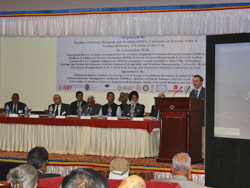
Wednesday 25 June:
Session theme: Living in a changing environment
Session theme: Sustainable Resources
Short Subject Presentations
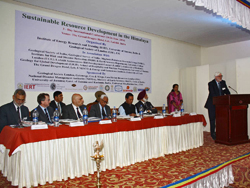 Thursday 26 June:
Thursday 26 June:
Session theme: Natural Hazards and Risks
Session theme: Tourism Opportunities and Challenges (Mountain, Heritage, Cultural and Sensitive Environments)
Student programme sponsors
back to top